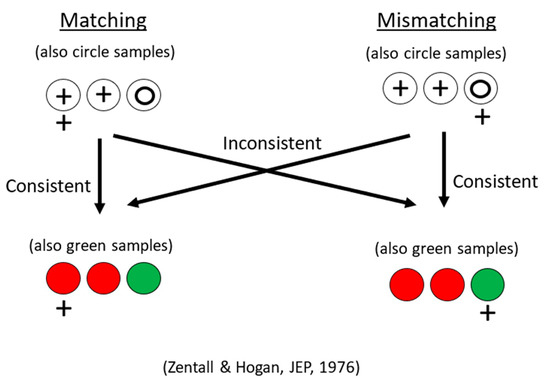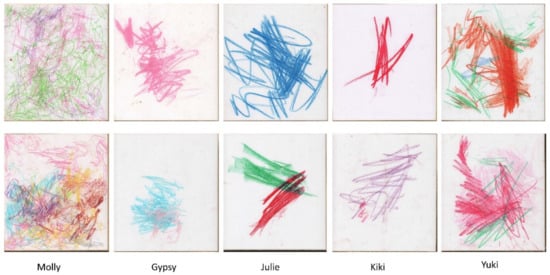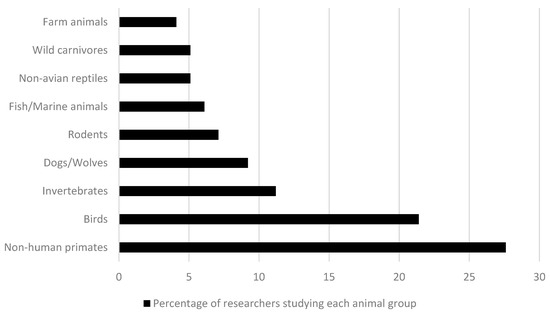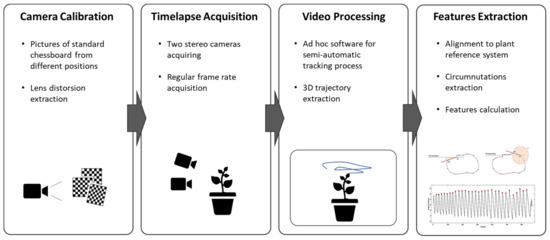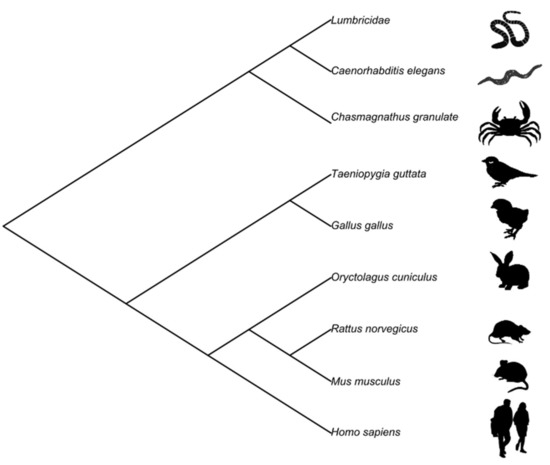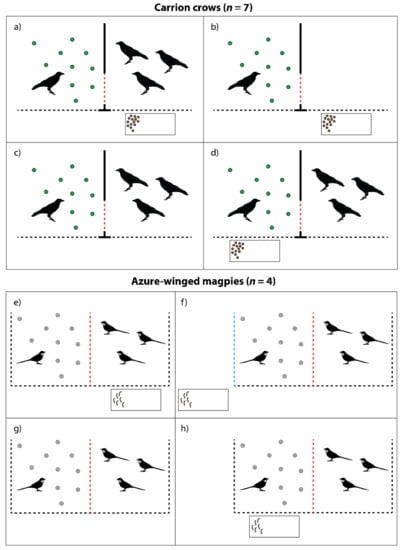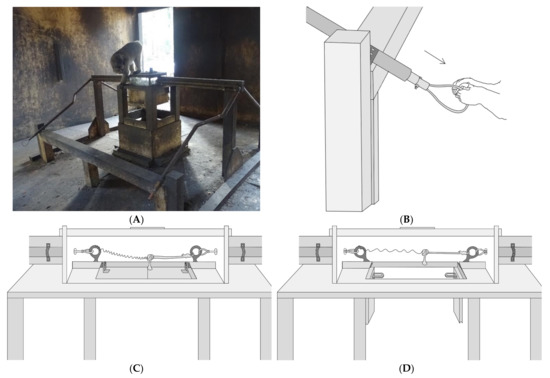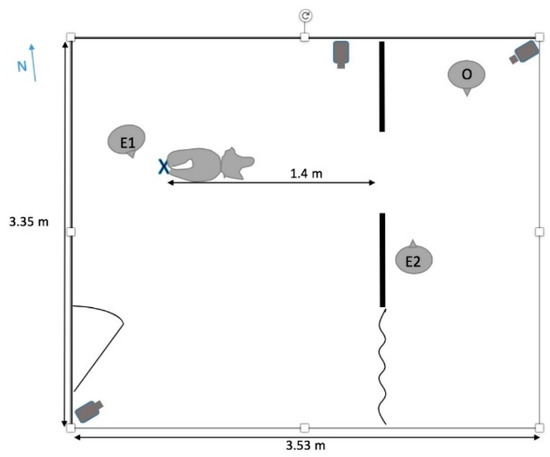Behavioural Methods to Study Cognitive Capacities of Animals
Printed Edition Available!
A printed edition of this Special Issue is available
here.
Share This Topical Collection
Editors
 Prof. Dr. Lucia Regolin
Prof. Dr. Lucia Regolin
 Prof. Dr. Lucia Regolin
Prof. Dr. Lucia Regolin
E-Mail
Website
Collection Editor
Department of General Psychology, University of Padova, Padova, Italy
Interests: animal cognition; comparative psychology; domestic chicken (Gallus gallus)
 Dr. Maria Loconsole
Dr. Maria Loconsole
 Dr. Maria Loconsole
Dr. Maria Loconsole
E-Mail
Website
Collection Editor
Department of General Psychology, University of Padova, Padova, Italy
Interests: animal cognition; comparative psychology; domestic chicken (Gallus gallus)
Topical Collection Information
Dear Colleagues,
Over the past 20 years, the scientific community has witnessed a growing interest in the comparative study of mental capabilities. Animal cognition has become an independent field of inter-disciplinary investigation, featuring specialized methodologies and paradigms tailored on diverse animal models. Recently, new approaches have emerged, offering access to large amounts of highly reliable data and to an enhanced explicatory power, at the cost of over-simplifying the behavioral response. On one hand are the automated and observer-independent techniques, which allow the collection of vast sets of data but may incur the risk of denaturing the meaning and richness of natural behaviors; on the other hand is the study of the neurobiological correlates of mental processes, which requires reference to standardized paradigms, posing constraints on the complexity and ecological validity of behavior. In contrast to these approaches, more traditional behavioral methods are firmly grounded on species’ ethology, considered crucial to grasp the distinctive qualitative features of the behavioral repertoire.
The present Topical Collection aims at offering a collection of contributions employing behavioral methods to investigate the mental abilities of animals or any other behaving organism. Studies focusing on species’ natural behavior or comparing behavioral methods with other methodologies are also welcome.
Prof. Dr. Lucia Regolin
Dr. Maria Loconsole
Collection Editors
Manuscript Submission Information
Manuscripts should be submitted online at www.mdpi.com by registering and logging in to this website. Once you are registered, click here to go to the submission form. Manuscripts can be submitted until the deadline. All submissions that pass pre-check are peer-reviewed. Accepted papers will be published continuously in the journal (as soon as accepted) and will be listed together on the collection website. Research articles, review articles as well as short communications are invited. For planned papers, a title and short abstract (about 100 words) can be sent to the Editorial Office for announcement on this website.
Submitted manuscripts should not have been published previously, nor be under consideration for publication elsewhere (except conference proceedings papers). All manuscripts are thoroughly refereed through a single-blind peer-review process. A guide for authors and other relevant information for submission of manuscripts is available on the Instructions for Authors page. Animals is an international peer-reviewed open access semimonthly journal published by MDPI.
Please visit the Instructions for Authors page before submitting a manuscript.
The Article Processing Charge (APC) for publication in this open access journal is 2400 CHF (Swiss Francs).
Submitted papers should be well formatted and use good English. Authors may use MDPI's
English editing service prior to publication or during author revisions.
Keywords
- animal cognition
- animal mind
- behavioral paradigms
- cognitive ethology
- comparative psychology
- animal intelligence
Published Papers (16 papers)
Open AccessEditorial
Behavioural Methods to Study Cognitive Capacities of Animals
by
Lucia Regolin and Maria Loconsole
Viewed by 766
Abstract
Over the past 20 years, the scientific community has witnessed a growing interest in the comparative study of mental capabilities [...]
Full article
Open AccessArticle
Alarm Calling in Plateau Pika (Ochotona curzoniae): Evidence from Field Observations and Simulated Predator and Playback Experiments
by
Meina Ma, Rui Hua, Darhan Bao, Guohui Ye, Zhuangsheng Tang and Limin Hua
Viewed by 1379
Abstract
Acoustic communication plays a vital role in passing or sharing information between individuals. Identifying the biological meaning of vocal signals is crucial in understanding the survival strategies of animals. However, there are many challenges in identifying the true meaning of such signals. The
[...] Read more.
Acoustic communication plays a vital role in passing or sharing information between individuals. Identifying the biological meaning of vocal signals is crucial in understanding the survival strategies of animals. However, there are many challenges in identifying the true meaning of such signals. The plateau pika (
Ochotona curzoniae) is a call-producing mammal endemic to the Qinghai–Tibet plateau (QTP) and considered a keystone species owing to its multiple benefits in alpine rangeland ecosystems. Previous studies have shown that plateau pikas emit alarm calls as part of their daily activities. However, only field observations have been used to identify these alarm calls of the plateau pika, with no attempts at using playback experiments. Here, we report the alarm calling of plateau pikas through field observations as well as simulated predator and playback experiments in the Eastern QTP from 2021 to 2022. We found that both female and male adults emitted alarm calls, the signals of which comprised only one syllable, with a duration of 0.1–0.3 s. There were no differences in the characteristics between the observed alarm calls and those made in response to the simulated predator. The duration of the alarm call response varied with altitude, with plateau pikas living at higher altitudes responding at shorter durations than those at lower altitudes.
Full article
►▼
Show Figures
Open AccessReview
Comparative Cognition Research Demonstrates the Similarity between Humans and Other Animals
by
Thomas R. Zentall
Cited by 1 | Viewed by 1931
Abstract
The field of comparative cognition represents the interface between the cognitive behavior of humans and other animals. In some cases, research demonstrates that other animals are capable of showing similar cognitive processes. In other cases, when animals show behavior thought to be culturally
[...] Read more.
The field of comparative cognition represents the interface between the cognitive behavior of humans and other animals. In some cases, research demonstrates that other animals are capable of showing similar cognitive processes. In other cases, when animals show behavior thought to be culturally determined in humans, it suggests that simpler processes may be involved. This review examines research primarily with pigeons (out of convenience because of their visual ability). I start with the concept of sameness and follow with the concept of stimulus equivalence, the building blocks of human language. This is followed by research on directed forgetting, the cognitive ability to maintain or forget information. A hallmark of cognition is transitive inference performance (if A < B, and B < C, the understanding that A < C), but the variety of species that show this ability suggests that there may be simpler accounts of this behavior. Similarly, experiments that demonstrate a form of cognitive dissonance in animals suggest that dissonance may not be necessary to explain this biased behavior. Furthermore, examples of sunk cost in pigeons suggests that the human need to continue working on a failing project may also have a biological basis. Finally, pigeons show a preference for a suboptimal choice that is similar to unskilled human gambling, a finding that may clarify why humans are so prone to engage in this typically losing activity.
Full article
►▼
Show Figures
Open AccessArticle
I Wanna Draw Like You: Inter- and Intra-Individual Differences in Orang-Utan Drawings
by
Marie Pelé, Gwendoline Thomas, Alaïs Liénard, Nagi Eguchi, Masaki Shimada and Cédric Sueur
Cited by 8 | Viewed by 6982
Abstract
This study analyses 749 drawings by five female Bornean orang-utans (
Pongo pygmaeus) at Tama Zoological Park in Japan. We searched for differences between individuals but also tried to identify possible temporal changes among the drawings of one individual, Molly, who drew
[...] Read more.
This study analyses 749 drawings by five female Bornean orang-utans (
Pongo pygmaeus) at Tama Zoological Park in Japan. We searched for differences between individuals but also tried to identify possible temporal changes among the drawings of one individual, Molly, who drew almost 1300 drawings from 2006 to 2011. An analysis of the drawings was carried out after collecting quantitative and qualitative variables. Our findings reveal evidence of differences in the drawing style of the five individuals as well as creative changes in Molly’s drawing style throughout her lifetime. Individuals differed in terms of the colours used, the space they filled, and the shapes (fan patterns, circles, or loops) they drew. Molly drew less and less as she grew older, and we found a significant difference between drawings produced in winter, when orang-utans were kept inside and had less activity, and those produced during other seasons. Our results suggest that the drawing behaviour of these five orang-utans is not random and that differences among individuals might reflect differences of styles, states of mind, and motivation to draw.
Full article
►▼
Show Figures
Open AccessEssay
Invasive Research on Non-Human Primates—Time to Turn the Page
by
Maria Padrell, Miquel Llorente and Federica Amici
Cited by 8 | Viewed by 3948
Abstract
Invasive research on primates (i.e., laboratory research that implies body manipulations causing pain or distress that is not aimed to directly improve the individuals’ well-being) has a long history. Although some invasive studies have allowed answering research questions that we could not have
[...] Read more.
Invasive research on primates (i.e., laboratory research that implies body manipulations causing pain or distress that is not aimed to directly improve the individuals’ well-being) has a long history. Although some invasive studies have allowed answering research questions that we could not have addressed with other methods (or at least not as quickly), the use of primates in invasive research also raises ethical concerns. In this review, we will discuss (i) recent advances in the study of primates that show evidence of complex behaviour and cognition, (ii) welfare issues that might arise when using primates in invasive research, (iii) the main ethical issues that have been raised about invasive research on primates, (iv) the legal protection that primates are granted in several countries, with a special focus on the principle of the 3Rs, and (v) previous and current attempts to ban the use of primates in invasive research. Based on this analysis, we suggest that the importance of a research question cannot justify the costs of invasive research on primates, and that non-invasive methods should be considered the only possible approach in the study of primates.
Full article
Open AccessArticle
Where Is Ethology Heading? An Invitation for Collective Metadisciplinary Discussion
by
Nereida Bueno-Guerra
Cited by 4 | Viewed by 3853
Abstract
Many factors can impact the advancement of scientific disciplines. In the study of animal behavior and cognition (i.e., Ethology), a lack of consensus about definitions or the emergence of some current events and inventions, among other aspects, may challenge the discipline’s grounds within
[...] Read more.
Many factors can impact the advancement of scientific disciplines. In the study of animal behavior and cognition (i.e., Ethology), a lack of consensus about definitions or the emergence of some current events and inventions, among other aspects, may challenge the discipline’s grounds within the next decades. A collective metadisciplinary discussion may help in envisioning the future to come. For that purpose, I elaborated an online questionnaire about the level of consensus and the researchers’ ways of doing in seven areas: Discipline name and concepts, species, Umwelt, technology, data, networking, and the impact of sociocultural and ecological factors. I recruited the opinion of almost a hundred of colleagues worldwide (
N = 98), both junior and seniors, working both in the wild and in the lab. While the results were pitted against the literature, general conclusions should be taken with caution and considered as a first attempt in exploring the state of the discipline from the researchers’ perspective: There is no unanimity for the discipline’s name; 71.4% of the researchers reported there is limited consensus in the definition of relevant concepts (i.e., culture, cognition); primate species still predominate in publications whereas the species selection criteria is sometimes based on fascination, chance, or funding opportunities rather than on biocentric questions; 56.1% of the apparatuses employed do not resemble species’ ecological problems, and current tech needs would be solved by fostering collaboration with engineers. Finally, embracing the Open Science paradigm, supporting networking efforts, and promoting diversity in research teams may help in gathering further knowledge in the area. Some suggestions are proposed to overcome the aforementioned problems in this contemporary analysis of our discipline.
Full article
►▼
Show Figures
Open AccessReview
A Review of the Model/Rival (M/R) Technique for Training Interspecies Communication and Its Use in Behavioral Research
by
Irene M. Pepperberg
Cited by 1 | Viewed by 2580
Abstract
In this paper, I will review the Model/Rival (M/R) technique that has been used to establish interspecies communication with Grey parrots (
Psittacus erithacus). I will describe the original format developed by Todt, the relationship to other forms of observational learning outlined
[...] Read more.
In this paper, I will review the Model/Rival (M/R) technique that has been used to establish interspecies communication with Grey parrots (
Psittacus erithacus). I will describe the original format developed by Todt, the relationship to other forms of observational learning outlined by other researchers, and the adaptations that I devised. I will describe how my undergraduate trainers and I isolated the various components that constitute the technique and explain how each is necessary, but how only the combination of
all components is sufficient for successful implementation—and how improper implementation can lead to failure. I will briefly summarize the results of proper implementation—including the importance of interspecies communication itself as a technique for studying animal cognition.
Full article
Open AccessArticle
Experimental Tests for Measuring Individual Attentional Characteristics in Songbirds
by
Loïc Pougnault, Hugo Cousillas, Christine Heyraud, Ludwig Huber, Martine Hausberger and Laurence Henry
Cited by 1 | Viewed by 2826
Abstract
Attention is defined as the ability to process selectively one aspect of the environment over others and is at the core of all cognitive processes such as learning, memorization, and categorization. Thus, evaluating and comparing attentional characteristics between individuals and according to situations
[...] Read more.
Attention is defined as the ability to process selectively one aspect of the environment over others and is at the core of all cognitive processes such as learning, memorization, and categorization. Thus, evaluating and comparing attentional characteristics between individuals and according to situations is an important aspect of cognitive studies. Recent studies showed the interest of analyzing spontaneous attention in standardized situations, but data are still scarce, especially for songbirds. The present study adapted three tests of attention (towards visual non-social, visual social, and auditory stimuli) as tools for future comparative research in the European starling (
Sturnus vulgaris), a species that is well known to present individual variations in social learning or engagement. Our results reveal that attentional characteristics (glances versus gazes) vary according to the stimulus broadcasted: more gazes towards unusual visual stimuli and species-specific auditory stimuli and more glances towards species-specific visual stimuli and hetero-specific auditory stimuli. This study revealing individual variations shows that these tests constitute a very useful and easy-to-use tool for evaluating spontaneous individual attentional characteristics and their modulation by a variety of factors. Our results also indicate that attentional skills are not a uniform concept and depend upon the modality and the stimulus type.
Full article
►▼
Show Figures
Open AccessArticle
Learning by Doing: The Use of Distance, Corners and Length in Rewarded Geometric Tasks by Zebrafish (Danio rerio)
by
Greta Baratti, Angelo Rizzo, Maria Elena Miletto Petrazzini and Valeria Anna Sovrano
Cited by 7 | Viewed by 4133
Abstract
Zebrafish spontaneously use distance and directional relationships among three-dimensional extended surfaces to reorient within a rectangular arena. However, they fail to take advantage of either an array of freestanding corners or an array of unequal-length surfaces to search for a no-longer-present goal under
[...] Read more.
Zebrafish spontaneously use distance and directional relationships among three-dimensional extended surfaces to reorient within a rectangular arena. However, they fail to take advantage of either an array of freestanding corners or an array of unequal-length surfaces to search for a no-longer-present goal under a spontaneous cued memory procedure, being unable to use the information supplied by corners and length without some kind of rewarded training. The present study aimed to tease apart the geometric components characterizing a rectangular enclosure under a procedure recruiting the reference memory, thus training zebrafish in fragmented layouts that provided differences in surface distance, corners, and length. Results showed that fish, besides the distance, easily learned to use both corners and length if subjected to a rewarded exit task over time, suggesting that they can represent all the geometrically informative parts of a rectangular arena when consistently exposed to them. Altogether, these findings highlight crucially important issues apropos the employment of different behavioral protocols (spontaneous choice versus training over time) to assess spatial abilities of zebrafish, further paving the way to deepen the role of visual and nonvisual encodings of isolated geometric components in relation to macrostructural boundaries.
Full article
►▼
Show Figures
Open AccessReview
Brain Lateralization and Cognitive Capacity
by
Lesley J. Rogers
Cited by 41 | Viewed by 9636
Abstract
One way to increase cognitive capacity is to avoid duplication of functions on the left and right sides of the brain. There is a convincing body of evidence showing that such asymmetry, or lateralization, occurs in a wide range of both vertebrate and
[...] Read more.
One way to increase cognitive capacity is to avoid duplication of functions on the left and right sides of the brain. There is a convincing body of evidence showing that such asymmetry, or lateralization, occurs in a wide range of both vertebrate and invertebrate species. Each hemisphere of the brain can attend to different types of stimuli or to different aspects of the same stimulus and each hemisphere analyses information using different neural processes. A brain can engage in more than one task at the same time, as in monitoring for predators (right hemisphere) while searching for food (left hemisphere). Increased cognitive capacity is achieved if individuals are lateralized in one direction or the other. The advantages and disadvantages of individual lateralization are discussed. This paper argues that directional, or population-level, lateralization, which occurs when most individuals in a species have the same direction of lateralization, provides no additional increase in cognitive capacity compared to individual lateralization although directional lateralization is advantageous in social interactions. Strength of lateralization is considered, including the disadvantage of being very strongly lateralized. The role of brain commissures is also discussed with consideration of cognitive capacity.
Full article
Open AccessFeature PaperArticle
Can Plants Move Like Animals? A Three-Dimensional Stereovision Analysis of Movement in Plants
by
Valentina Simonetti, Maria Bulgheroni, Silvia Guerra, Alessandro Peressotti, Francesca Peressotti, Walter Baccinelli, Francesco Ceccarini, Bianca Bonato, Qiuran Wang and Umberto Castiello
Cited by 10 | Viewed by 2365
Abstract
In this article we adapt a methodology customarily used to investigate movement in animals to study the movement of plants. The targeted movement is circumnutation, a helical organ movement widespread among plants. It is variable due to a different magnitude of the trajectory
[...] Read more.
In this article we adapt a methodology customarily used to investigate movement in animals to study the movement of plants. The targeted movement is circumnutation, a helical organ movement widespread among plants. It is variable due to a different magnitude of the trajectory (amplitude) exhibited by the organ tip, duration of one cycle (period), circular, elliptical, pendulum-like or irregular shape and the clockwise and counterclockwise direction of rotation. The acquisition setup consists of two cameras used to obtain a stereoscopic vision for each plant. Cameras switch to infrared recording mode for low light level conditions, allowing continuous motion acquisition during the night. A dedicated software enables semi-automatic tracking of key points of the plant and reconstructs the 3D trajectory of each point along the whole movement. Three-dimensional trajectories for different points undergo a specific processing to compute those features suitable to describe circumnutation (e.g., maximum speed, circumnutation center, circumnutation length, etc.). By applying our method to the approach-to-grasp movement exhibited by climbing plants (
Pisum sativum L.) it appears clear that the plants scale movement kinematics according to the features of the support in ways that are adaptive, flexible, anticipatory and goal-directed, reminiscent of how animals would act.
Full article
►▼
Show Figures
Open AccessReview
Context-Specific Habituation: A Review
by
Andrea Dissegna, Massimo Turatto and Cinzia Chiandetti
Cited by 14 | Viewed by 5892
Abstract
Habituation consists of the progressive response decrement to a repeated stimulation, a response decline that is not accounted for by sensory or motor fatigue. Together with sensitization, habituation has been traditionally considered to be a prototypical example of non-associative learning, being affected only
[...] Read more.
Habituation consists of the progressive response decrement to a repeated stimulation, a response decline that is not accounted for by sensory or motor fatigue. Together with sensitization, habituation has been traditionally considered to be a prototypical example of non-associative learning, being affected only by the features of the stimulation, as for instance its intensity or frequency. However, despite this widespread belief, evidence exists showing that habituation can be specific to the context of the stimulation, thus suggesting that habituation can have an associative nature. Such an unexpected characteristic of habituation was in fact predicted by a theoretical model of associative learning proposed by Wagner in a series of works that appeared in the late 1970s. Here, we critically review the experimental data that since then have been accumulated in support of this hypothesis. What emerges from the literature is that context-specific habituation is common to several animal species and that the ability to form an association between the habituating stimulus and its context is independent of the complexity of the animal’s nervous system. Finally, context-specific habituation is observed for a variety of organism’s responses, ranging from visceral to motor and mental activities.
Full article
►▼
Show Figures
Open AccessReview
The Challenge of Illusory Perception of Animals: The Impact of Methodological Variability in Cross-Species Investigation
by
Maria Santacà, Christian Agrillo and Maria Elena Miletto Petrazzini
Cited by 7 | Viewed by 3456
Abstract
Although we live on the same planet, there are countless different ways of seeing the surroundings that reflect the different individual experiences and selective pressures. In recent decades, visual illusions have been used in behavioural research to compare the perception between different vertebrate
[...] Read more.
Although we live on the same planet, there are countless different ways of seeing the surroundings that reflect the different individual experiences and selective pressures. In recent decades, visual illusions have been used in behavioural research to compare the perception between different vertebrate species. The studies conducted so far have provided contradictory results, suggesting that the underlying perceptual mechanisms may differ across species. Besides the differentiation of the perceptual mechanisms, another explanation could be taken into account. Indeed, the different studies often used different methodologies that could have potentially introduced confounding factors. In fact, the possibility exists that the illusory perception is influenced by the different methodologies and the test design. Almost every study of this research field has been conducted in laboratories adopting two different methodological approaches: a spontaneous choice test or a training procedure. In the spontaneous choice test, a subject is presented with biologically relevant stimuli in an illusory context, whereas, in the training procedure, a subject has to undergo an extensive training during which neutral stimuli are associated with a biologically relevant reward. Here, we review the literature on this topic, highlighting both the relevance and the potential weaknesses of the different methodological approaches.
Full article
►▼
Show Figures
Open AccessArticle
Carrion Crows and Azure-Winged Magpies Show No Prosocial Tendencies When Tested in a Token Transfer Paradigm
by
Lisa Horn, Jeroen S. Zewald, Thomas Bugnyar and Jorg J. M. Massen
Cited by 5 | Viewed by 2780
Abstract
To study the evolution of humans’ cooperative nature, researchers have recently sought comparisons with other species. Studies investigating corvids, for example, showed that carrion crows and azure-winged magpies delivered food to group members when tested in naturalistic or simple experimental paradigms. Here, we
[...] Read more.
To study the evolution of humans’ cooperative nature, researchers have recently sought comparisons with other species. Studies investigating corvids, for example, showed that carrion crows and azure-winged magpies delivered food to group members when tested in naturalistic or simple experimental paradigms. Here, we investigated whether we could replicate these positive findings when testing the same two species in a token transfer paradigm. After training the birds to exchange tokens with an experimenter for food rewards, we tested whether they would also transfer tokens to other birds, when they did not have the opportunity to exchange the tokens themselves. To control for the effects of motivation, and of social or stimulus enhancement, we tested each individual in three additional control conditions. We witnessed very few attempts and/or successful token transfers, and those few instances did not occur more frequently in the test condition than in the controls, which would suggest that the birds lack prosocial tendencies. Alternatively, we propose that this absence of prosociality may stem from the artificial nature and cognitive complexity of the token transfer task. Consequently, our findings highlight the strong impact of methodology on animals’ capability to exhibit prosocial tendencies and stress the importance of comparing multiple experimental paradigms.
Full article
►▼
Show Figures
Open AccessArticle
Exploring the Cognitive Capacities of Japanese Macaques in a Cooperation Game
by
Ryan Sigmundson, Mathieu S. Stribos, Roy Hammer, Julia Herzele, Lena S. Pflüger and Jorg J. M. Massen
Cited by 7 | Viewed by 2684
Abstract
Cooperation occurs amongst individuals embedded in a social environment. Consequently, cooperative interactions involve a variety of persistent social influences such as the dynamics of partner choice and reward division. To test for the effects of such dynamics, we conducted cooperation experiments in a
[...] Read more.
Cooperation occurs amongst individuals embedded in a social environment. Consequently, cooperative interactions involve a variety of persistent social influences such as the dynamics of partner choice and reward division. To test for the effects of such dynamics, we conducted cooperation experiments in a captive population of Japanese macaques (
Macaca fuscata, N = 164) using a modified version of the loose-string paradigm in an open-experiment design. We show that in addition to becoming more proficient cooperators over the course of the experiments, some of the macaques showed sensitivity to the presence of potential partners and adjusted their behavior accordingly. Furthermore, following an unequal reward division, individuals receiving a lesser reward were more likely to display aggressive and stress-related behaviors. Our experiments demonstrate that Japanese macaques have some understanding of the contingencies involved in cooperation as well as a sensitivity to the subsequent reward division suggestive of an aversion to inequity.
Full article
►▼
Show Figures
Open AccessArticle
Can Dogs Limbo? Dogs’ Perception of Affordances for Negotiating an Opening
by
Alexandra Horowitz, Eloise West, Molly Ball and Blakeley Bagwell
Cited by 3 | Viewed by 5120
Abstract
Very little research has focused on canines’ understanding of their own size, and their ability to apply this understanding to their surroundings. The current study tests domestic dogs’ judgment of their body size in relation to a changing environment in two novel experimental
[...] Read more.
Very little research has focused on canines’ understanding of their own size, and their ability to apply this understanding to their surroundings. The current study tests domestic dogs’ judgment of their body size in relation to a changing environment in two novel experimental situations: when encountering an opening of decreasing height (Study 1) and when negotiating an opening when carrying a stick in their mouth (Study 2). We hypothesized that if dogs understand their own body size, they will accurately judge when an opening is too small for their body to fit through, showing longer latencies to approach the smaller openings and adjusting their body appropriately to get through—although this judgment may not extend to when their body size is effectively increased. In line with these hypotheses, we found that the latency for subjects to reach an aperture they could easily fit through was significantly shorter than to one which was almost too small to fit through. We also found that the order of subjects’ adjustments to negotiate an aperture was invariant across individuals, indicating that dogs’ perception of affordances to fit through an aperture is action-scaled. Preliminary results suggest that dogs’ approach behavior is different when a horizontal appendage is introduced, but that dogs were able to alter their behavior with experience. These results are consistent with the hypothesis that dogs understand their own body size and the affordances of their changing environment.
Full article
►▼
Show Figures
Planned Papers
The below list represents only planned manuscripts. Some of these
manuscripts have not been received by the Editorial Office yet. Papers
submitted to MDPI journals are subject to peer-review.
Title: Behaving in an ambiguous world: hemispheric specialization and meta-control
Authors: Martina Manns
Affiliation: Division of Experimental and Molecular Psychiatry, Department of Psychiatry, Psychotherapy and Preventive Medicine, Ruhr-University Bochum, Bochum, Germany
Abstract: Left-right differences in neural structures and functions influence a large number of fitness behaviors in animals as diverse as nematodes, bees, fish, birds or humans. A division of labor between the two halves of the brain enables simultaneous coping with two tasks whereby each hemisphere attends to different aspects of the environment, adopts different analysis strategies, or controls different cognitive functions. However, these differences can lead to interhemispheric conflicts when the two sides of the brain generate incompatible response options. To avoid time-consuming delays in behavioral responses, the brain needs to develop efficient strategies for conflict solving. In this regard, meta-control, i.e. the dominance of one hemisphere of the brain in conflict situations, can be an important organizational principle. I will therefore report on behavioral experiments that allow analyzing conflict decision patterns and the underlying neural mechanisms in different species.








